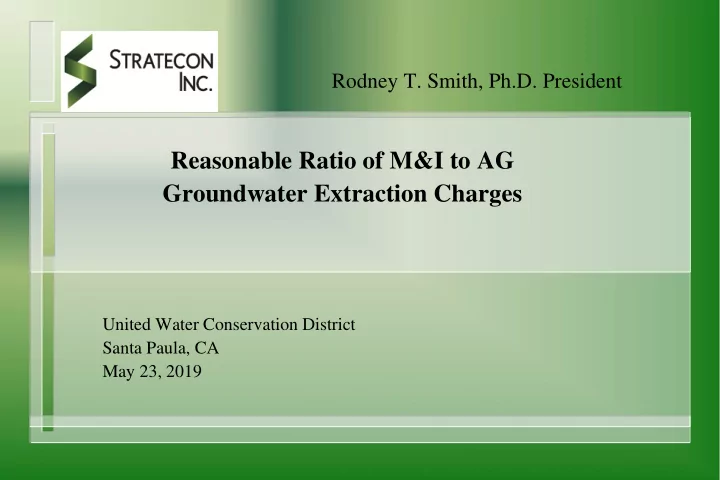

Rodney T. Smith, Ph.D. President Reasonable Ratio of M&I to AG Groundwater Extraction Charges United Water Conservation District Santa Paula, CA May 23, 2019
Statement of Question Develop a quantitative method to determine a reasonable ratio of groundwater extraction charges Municipal & Industrial (“non-agricultural”) water to agricultural (“AG”) water Focus on the differential hydrological impact of M&I and AG groundwater usage and land use on the eight inter-connected basins within United How differential hydrological impact creates a need for replenishment projects and activities from United How the rate structure should reflect these differences 2
Economic Principles of Rate Structure 3
United Water’s Objectives and Sources of Revenues and Costs Groundwater Overdraft Groundwater Pumping Recharge Overlying Lands Contributions to Basins United Water Revenues Recharge Natural Recharge Groundwater Recharge Replenishment Cost of Streams and Activity Replenishment Undeveloped Lands Lake Piru Freeman Diversion Rainfall/Runoff Spreading Grounds 4
Principle 1: Components of Fee for Water User Class Fee = Variable Cost Component + Fixed Cost Component Variable Cost Component: replenishment costs that vary with the volume of replenishment projects and activities (estimated @ 10% of total replenishment costs) Fixed Cost Component: replenishment costs that do not vary with the volume of replenishment projects and activities (estimated @ 90% of total replenishment costs) 5
Principle 2: Variable Cost Component Based on Impact of Pumping on Overdraft Impact of pumping on overdraft: pumping less groundwater reuse AG Variable Cost Component: 75.9% of variable cost M&I Variable Cost Component: 85.2% of variable cost 6
Principle 3: Fixed Cost Component based on apportionment rules Rule 1: apportion fixed cost according to relative demands water user class places on United for replenishment projects and activities Share based on groundwater pumping adjusted for reuse Rule 2: credit water user class based on amount of differential recharge on overlying lands relative to districtwide average Differential recharge per acre: AG (0.07 AF/acre); M&I (-0.14 AF/acre) adjusted by portion of recharge that benefits the inter-connected basins Annual cost of replenishment projects and activities 7
Consistent With Cost-of-Service, Rate-Making Principles United Water undertakes projects to mitigate the effects of groundwater overdraft For a parcel, demand for United Water’s services reflect water use and land use Stratecon’s method United Water’s variable cost: comparable to commodity charge United Water’s fixed cost: comparable to demand charge 8
United Water’s Cost of Replenishment Projects and Activities 9
United Water Projects to Address Groundwater Overdraft Ferro/Rose (retirement of groundwater allocation) annual cost of replenishment activity: $1,220 per acre-foot (firm replenishment) Ferro/Rose (recharge project) annual capital cost of replenishment activity: $919/acre-foot (non-firm replenishment) Desalination of brackish groundwater project (annual cost) For 10,000 acre-foot annual design capacity: $1,300 per acre-foot to $1,495 per acre-foot For 20,000 acre-foot annual design capacity: $1,168 per acre-foot to $1,326 per-acre foot 10
Other Water Initiatives in Ventura County City of Ventura “Water Rights Dedication and Water Resources Net Zero Fee Ordinance” Estimated fee for 2019: $29,135 Annual cost of $1,779 per acre foot Fox Canyon Groundwater Management Agency surcharge to bring pumping to safe yield $1,961/AF for excess pumping of more than 100 acre feet per year Casitas Connection to State Water Project (annual cost per expected yield) Capital Cost: $1,491AF Replacement Cost: $242/AF SWP charges: $1,170/AF Total: $2,903/AF 11
Reasonable Ratio for Groundwater Extraction Charges 12
Assumptions Groundwater Revenue including in-lieu: $18,166,030 Groundwater pumping and in-lieu: agricultural (143,260 acre-feet) and municipal & industrial (34,540 acre feet) Hydrologic Conditions Reuse of groundwater: agricultural (24.1%) and municipal & industrial (14.8%) Overlying recharge for lands: agricultural (0.56 acre-feet per acre) and municipal & industrial (0.35 acre-feet per acre) Acreage: Agricultural (80,078 acres) and Municipal & Industrial (40,918 acres) 13
Figure 2 Threshold Annual Cost of Replenishment Projects and Activities by Proportion of Potential Recharge on Overlying Lands Beneficially Reaching the Basin ($/AF) $1,865 If United Water's annual cost of replenishment projects and activities exceed the threshold, then a reasonnable ratio of municipal & industrial to agricultural groundwater extraction charges exceeds 3.0 ratio $1,306 $871 $726 35% 50% 75% 90% Proportion of Potential Recharge on Overlying Lands Benefically Reaching the Basin 14
Conclusion A ratio of at least 3.0 for M&I to AG groundwater extraction charges reasonably reflects the quantitative differences between the hydrologic impacts of the different water user classes 15
Recommend
More recommend